Chapter 6. Non-Parenteral Medication Administration
6.7 Administering Topical Medications
In this section we address how to administer topical medication by two delivery methods: transdermal patches, and creams, lotions, or ointments. Always wear gloves and maintain standard precautions when administering topical medications to the skin, mucous membranes, and tissues. Do not touch any preparations to your own skin. Always clean the skin or wound before applying a new dose of topical medication.
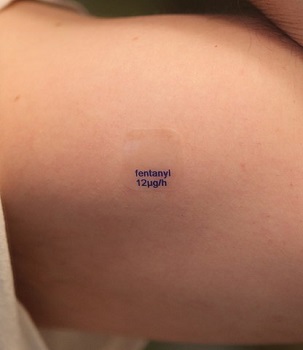 |
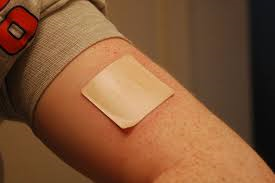 |
Checklist 55 lists the steps for applying a transdermal patch.
Checklist 55: Applying a Transdermal PatchDisclaimer: Always review and follow your agency policy regarding this specific skill. |
|||
Safety considerations:
|
|||
Steps |
Additional Information |
||
| 1. Perform hand hygiene before medication preparation.
Check MAR to guide you to which medication you are preparing. Follow agency policy to ensure MARs are accurate and verified appropriately. |
 A MAR that is checked by more than one healthcare professional provides a very reliable record for administering medications. Agencies may vary in relation to MAR verification processes. |
||
2 a. As you are removing medications from the dispensing system or drawer, perform the SEVEN rights three times with each individual medication:
|
The right patient: Check that you have the correct patient using two patient identifiers (e.g., name and date of birth).
The right medication (drug): Check that you have the correct medication and that it is appropriate for the patient in the current context. The right dose: Check that the dose makes sense for the age, size, and condition of the patient. Different dosages may be indicated for different conditions. The right route: Check that the route is appropriate for the patient’s current condition. The right time: Adhere to the prescribed dose and schedule. The right reason: Check that the patient is receiving the medication for the appropriate reason. The right documentation: Always verify any unclear or inaccurate documentation prior to administering medications. |
||
2 b. The label on the medication must be checked for name, dose, and route, and compared with the MAR at three different times:
|
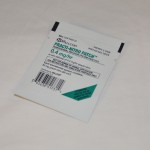 Whenever possible, take the MAR to the bedside. |
||
| 3. Before applying a transdermal patch, remove the old patch if it is still in place. Clean area thoroughly.
Observe for signs of skin irritation at old patch and document as per agency policy. |
Not removing the previous patch may result in overdose of the medication. Check between skin folds for old patch(es).
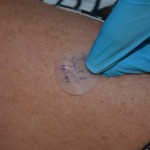 |
||
| 4. Dispose of old patch as per agency policy (usually in a biohazard trash bag) by folding in half with sticky sides together and wrapping it in a glove, or cutting it before disposal. | This prevents accidental exposure to the medication.
Discarded fentanyl patches are considered a controlled substance. Many facilities require a witness for discard of these. |
||
| 5. Use a felt tip or soft tip pen to write the date, time, and your initials on the outside of the new patch. DO NOT use a ballpoint pen.
Find a new site that is clear, dry, hairless, and free of skin irritations. |
Initialing the patch communicates application date and time to other healthcare providers.
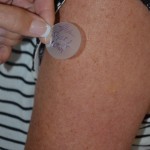 Ballpoint pen can damage patch and thus affect medication delivery. If it is necessary to remove hair, clip the hair instead of shaving to avoid skin irritation. A consistent surface ensures even medication distribution. |
||
| Note: For some medications (i.e. nitroglycerine) it is normal to have a “patch-free period” (also called a wash out time) of 10 to 12 hours when the patch is removed, because tolerance to the medication may develop if the patch is worn 24 hours/day. Follow the prescriber’s order. | |||
| 6. Carefully remove the backing from the patch, taking care to hold it at the edges and not touch the medication with your fingers. | This prevents interference with medication and maintains stickiness of patch. | ||
| 7. Apply patch by holding one hand firmly over the patch for 10 seconds, then press around the edges to make sure that the patch is securely attached to the skin. | This prevents loss of patch and ensures effectiveness of medication delivery.
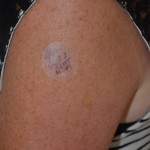 |
||
| 8. Perform hand hygiene. | This prevents the transfer of microorganisms. | ||
| 9. Document as per agency policy, making sure to include site of administration on the MAR. | Accurate and timely documentation improves patient safety. | ||
| Data source: BCIT, 2015; Lilley et al., 2016; Perry et al., 2018 | |||
Checklist 56 lists the steps for applying topical medications as creams, lotions, and ointments.
Checklist 56: Applying Topical Creams, Lotions, and OintmentsDisclaimer: Always review and follow your agency policy regarding this specific skill. |
|||
Safety considerations:
|
|||
Steps |
Additional Information |
||
| 1. Perform hand hygiene before medication preparation. Check MAR to guide you to which medication you are preparing. Follow agency policy to ensure MARs are accurate and verified appropriately. |
 An MAR that is checked by more than one healthcare professional provides a very reliable record for administering medications. Agencies may vary in relation to MAR verification processes. |
||
2 a. As you are removing medications from the dispensing system or drawer, perform the SEVEN rights three times with each individual medication:
|
The right patient: Check that you have the correct patient using two patient identifiers (e.g., name and date of birth).
The right medication (drug): Check that you have the correct medication and that it is appropriate for the patient in the current context. The right dose: Check that the dose makes sense for the age, size, and condition of the patient. Different dosages may be indicated for different conditions. The right route: Check that the route is appropriate for the patient’s current condition. The right time: Adhere to the prescribed dose and schedule. The right reason: Check that the patient is receiving the medication for the appropriate reason. The right documentation: Always verify any unclear or inaccurate documentation prior to administering medications. |
||
2 b. The label on the medication must be checked for name, dose, and route, and compared with the MAR at three different times:
|
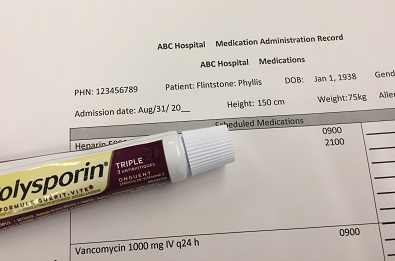 Whenever possible, take the MAR to the bedside to complete the third check. |
||
| 3. Consider where the lotion, cream, or ointment is to be applied. A cotton tipped applicator might suffice. If applying to a large area of skin, apply non-sterile gloves unless skin is broken; then apply sterile gloves. | Using gloves protects healthcare provider from contact with medication.
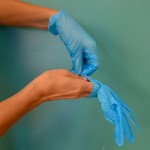 If skin is broken, sterile gloves will prevent introduction of new microorganisms from the health care provider’s hands. |
||
| 4. Wash, rinse, and dry the affected area with water and a clean cloth. | This removes previous topical medications. | ||
| 5. If skin is very dry and flaking, apply topical medication while skin is still damp. | Applying while skin is damp helps to retain moisture within skin layers. | ||
| 6. Change gloves, performing hand hygiene in between. |
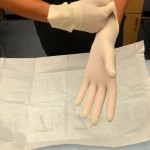 |
||
| 7. Place required amount of medication in palm of hands and soften by rubbing palms together.
Likewise, if using a cotton tipped applicator, apply ointment, lotion, or cream to it. |
Softening makes topical medication easier to spread.
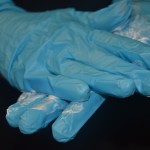 If having to go back into the container, use a sterile tongue depressor or cotton tipped applicator so as not to contaminate the medication. |
||
| 8. Let patient know that initial application may feel cold. Apply medication using long even strokes that follow the direction of the hair. Do not rub vigorously. | This prevents irritation of hair follicles. | ||
| 9. Let patient know that skin may feel greasy after application. | Some topical medications contain oils. | ||
| 10. Document as per agency policy, making sure to include site of administration on the MAR. | Accurate and timely documentation improves patient safety. | ||
| 11. Perform hand hygiene. | This step prevents the transfer of microorganisms. | ||
| Data sources: BCIT, 2015; Lilley et al., 2016; Perry et al., 2018. | |||
Critical Thinking Exercises
- Your patient’s MAR states that their Nitro-Patch should be removed at night. Please explain why this is considered safe practice.
- Discuss the steps you would take to administer a lotion for a patient with a rash that has several open lesions.
Attributions
Figure 6.29. Fentanyl patch by DanielTahar is used under a CC BY-SA 4.0 international license.
Figure 6.30. Nicoderm [patch] by RegBarc is used under a CC BY 2.5 generic license.
Figure 6.31. Topical cream with MAR by author is licensed under a Creative Commons Attribution 4.0 International License.

